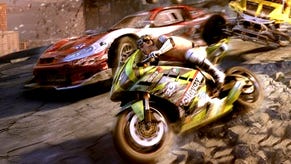MotorStorm: Pacific Rift
Cloudy.
But these moments of inspiration are ultimately fleeting. The bumpy downhill rush of Caldera Ridge is unique, despite its obvious potential, and the majority of tickets attempt to perform too many of the game's many instruments in chorus, which comes across as noisy and indistinct. Equally, too many of the tracks force you into uphill struggles that emphasise a general lack of speed, while some of them layer on too many branching paths until you actually get lost; and although the bikes and buggies are almost always great, other vehicle classes are weaker or still too similar to one another: the big rigs are ponderous, rally cars have many of the buggies' weaknesses but few of their redeeming features, and the mudplugger's mundane handling is less flattering even than its name. Monster trucks are best in the hands of the AI, where they're used to smash and intimidate you, but they're too often lost for balance or grip when you get behind the wheel. The tickets force you to use all the vehicles at some point - a decision no doubt taken to show you around the game, but one that backfires occasionally when the choice is only between tedium and obsolescence.
In amongst the traditional 16-vehicle races there are also Eliminator and Speed events, which have to be unlocked by avoiding crashes or finishing within a certain time limit in the preceding race. Eliminator, where the last-placed car is blown up every 15 seconds, is good but inessential, and Speed, where you manoeuvre between checkpoint gates marked by flares, is ultimately frustrating because the game only shows you the next checkpoint, rather than the next two. With grip at such a premium and speed obviously a necessity, you almost always need several attempts to memorise the route before you can orientate yourself correctly each time and get on with the business of trying to get to the end with time left on the clock.
Visually, Pacific Rift has turned out better than we had been led to expect by preview builds and trailers, as the lighting conditions, which change depending on the time of day, and draw distance and horizon graphics restore a reputation blemished by a few ugly near and middle-distance textures. The first game's troubling glitches have been all but eliminated, too: we only blew up at a terrain transition once in the whole game, whereas the original was often guilty of letting you down in that regard. Negligible load times for the simplified vehicle selector and a near-instant restart from the pause menu are much-needed additions as well, even if tracks do initially take a while to load, and online there's a ranking system, better matchmaking and very little noticeable lag to record, while the promised split-screen racing sacrifices less detail than you would expect, even with four players. The frame-rate rarely tumbles from 30fps in the ten hours it takes to reach the latter stages of the Festival.

However, the inconsistent quality of Pacific Rift's tracks and vehicles ultimately gets the better of it, and there are other problems to compound these drawbacks. It's all too easy to dominate for half the Festival's duration, and when the difficulty does ascend as you graduate to ranks 5 and 6 you're allowed almost no mistakes in the quest for a top-three position. As a result you start to feel worse about being taken out when you can hardly anticipate it - rejoining a thoroughfare on a bike just as a monster truck surges through at improbable speed, for example. You have to let go of the urge to only move on when you achieve gold medals in order to stave off crippling frustration, and despite an experience system that unlocks more events even without the shiniest medals, the challenge of levelling up is only really relevant just as the Festival tightens toward its conclusion, by which time the contrasting sensations of repetition and frustration have almost squeezed out the moments of real entertainment that are intermittently promised by the first few hours of easy progress.
Those moments, when MotorStorm: Pacific Rift is at its best, are the ones where it lives up to its name - dragging a flimsy bike or buggy around searching for grip in the path of the devastating storm of your opposition - and of its 16 circuits around half are clever, challenging and memorable, at least in spurts, and serve the enjoyable multiplayer better than the patchy campaign. There, too much of your time is spent grinding second-choice metal in search of elusive pace, or cursing imperious AI and unpredictable catastrophe, and in the battle between the game's infrequent but electrifying highs and its frustrating lows, the result is too close to stalemate to match the first game's understated achievement.


